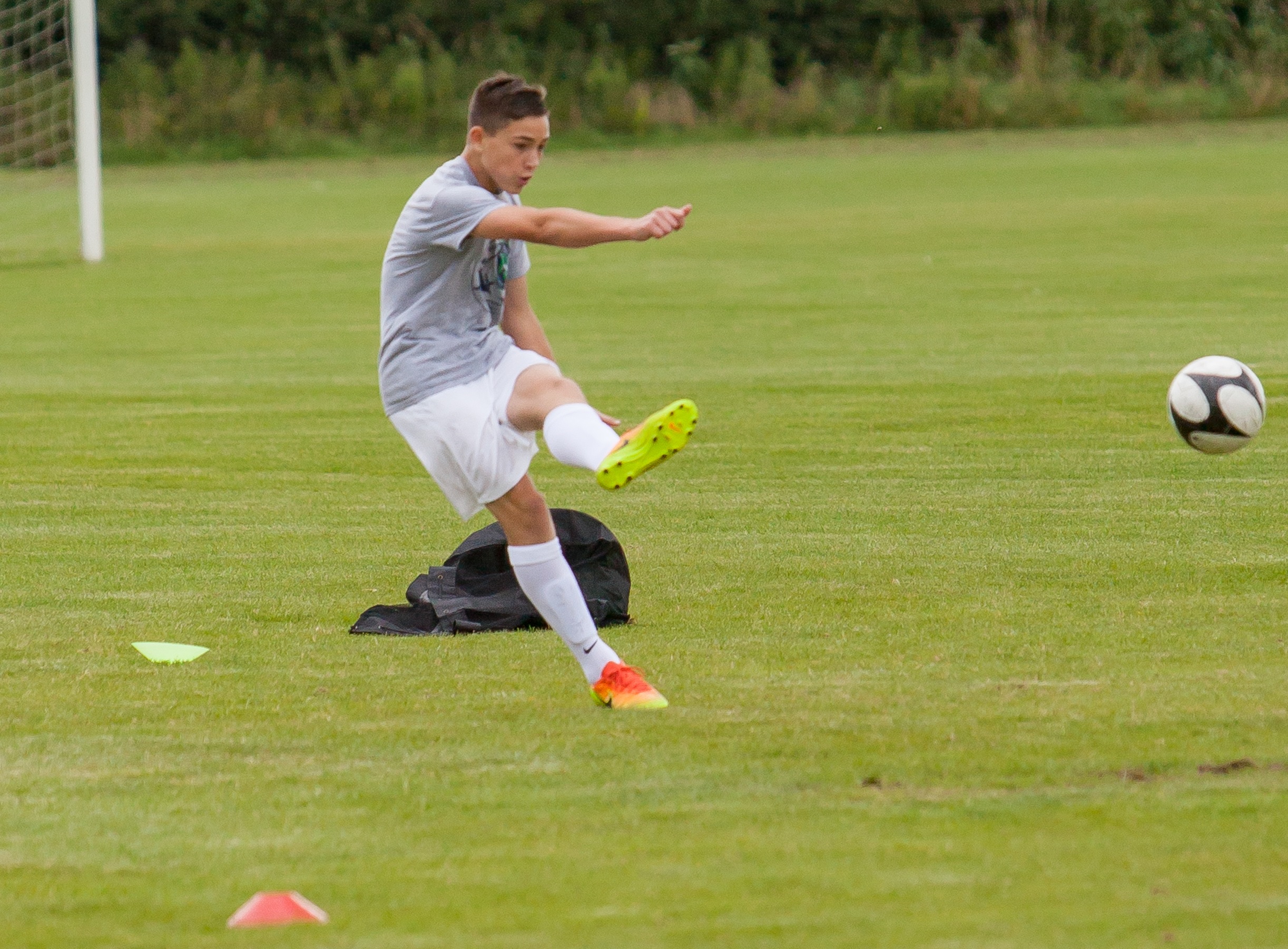During the years 2010 to 2014 I received the football equivalent of a Masters Degree in ‘The importance of movement… ’ from Roberto Martinez, at Wigan Athletic. His demand for players in the academy to have a full understanding and application of 1v1 moments was a true game changer for me on my coaching journey. I had always been a keen advocate of players dominating 1v1 situations after studying Rene Mulensteen’s programme at Man United, however, looking back at the session content and design that we implemented throughout the YDP age groups at Wigan, I promoted an over-emphasis on the typical Defender in Front scenario. It was the classic attacker dribbling in a confined space at the opponent defending a target behind. But Roberto’s 1v1 principles, to summarise, focused on players dominating in five areas. These were: defender in front, defender on the side, defender behind, defender on the angle and dominating the opponent without the ball. He broke these areas up percentage wise, positionally and how different they look for each player’s identity. As an example, over 80% of pressure at the elite level (all players and positions) comes from behind/side but for a centre back that figure would be less than 10%. If a player is on the ball, in total, for 60-90 seconds in a game, then for 88.5 minutes they are without it. The exact number of minutes would vary depending on the specific game, playing style and possession dominance but we can conclude that for long periods of the game players are searching for space to receive.
In 2014 I moved to Liverpool as a coach where we worked off a principle called ‘7:1 movements’. The analysis department had studied Champions League front half players and found that, on average, they receive the ball once in every seven movements made. The types of 7:1 movement will vary depending upon each player’s position and more specifically, their individual identity.
Example 1, a winger. Their movements would vary depending on the collective action and position on the pitch. If the ball is being circulated slowly across the back line and the team have pinned the opponent on the edge of their own box (think Man City or Liverpool) then the movement would be fast and explosive double movements to create space to free themselves up one v one against the opponent’s full back. Thus as the ball circulates, the winger may run the full back in behind to get him going backwards and then drop in to feet to free up space 1v1 (then defender in front techniques become applicable with the ball) or he may do the opposite; run short to draw the full back out to then explode in behind creating space to stay onside with momentum to receive behind the full back. He may also pull the full back wide so the distance between them and their centre back is extended and then make a late piercing run inside to receive a through ball in behind. However, during the build up phase in their own half, the winger may vary movement more to become the free player inside to create clean progressions to get up the pitch; their movements would therefore be more slow and drifting ones inside.
Example 2, a number ten. During my time at Wigan, Terry Phelan worked as a coach with our academy age groups and I was discussing unpredictable movement off the front players with him. He told me a story of playing with Gianfranco Zola; ‘… his movement was incredible. We had a target striker and Zola’s movements all came off him. He worked in an arc which the gaffer called a smiley face, and all his movements were based on this imaginary line wherever we were on the pitch. If a deep lyer marked him he could run off shoulders, play off the sides, support with third man run underneath, drift off the lines but always his range of movements were in the arc/smiley face off the nose (number 9). He had free licence for movements but they all worked within this shape.’ Now Zola’s movements, in 360 degree pressure, would be completely different to a winger’s who predominantly has the touchline to their back or a centre back who is frequently pressed from the front and angle.
Example 3, a deep lying controller. The spider in the web who connects everything sitting in front of the back line has a huge responsibility off the ball. They must be the free player constantly to create clean progressions up the pitch. A player in this position rarely needs to display the explosive double movements that a winger would do, instead they will focus more on drifting, playing off shoulders, creating angles, not being in straight lines behind opponents, being in positions where, by the time they receive the ball, they can go forward on their first touch (the farther away from the man in possession, the greater the space needed) It is all about angles, angles, angles and is mentally a draining position to play if done efficiently.
These three simplified examples highlight how imperative it is that coaches incorporate their own interpretation of 7:1 movements as a general key principle but the specifics then vary depending on the position and identity of that particular player. In my experience, players of all levels are too quick to become frustrated and stop showing for the ball after not receiving it. The principle of 7:1 teaches players to continually think, move and evolve space from an individual point of view; a principle that then can be applied to any system or style of play. The complete opposite of this is developing predictable movement patterns, such as the 6 rotates with the 8 when the RCB circulates. I used to be a big pattern coach until I realised the limitations of it long term. Patterns become predictable and mean that players have no solutions once part of that pattern is taken away, in fact in my experience it generally creates an excuse mentality and sets them up to fail but this is for a much longer article.
From a defensive point of view, the game at the top level becomes more organised, compact and teams recover faster into shape with each season that passes by. The consequence of this is that players will have to find solutions within compact defensive structures, regardless of whether this is a low, medium or high setup on the pitch. The ability to play inside that jungle indeed requires technical proficiency but also an ability to create space through individual and unpredictable movement. Movement and understanding of space is one of the key differentiators between good and great players. As examples, Paul Pogba has an outstanding technical profile; if you put his game under the microscope and graded him on technical proficiency alone, he would score extremely high on most, if not all, areas. He is technically a world class talent displaying an array of passing techniques, receiving skills, aerial control, finishing techniques etc. However, his movement to receive and ability to find space means that he is never on the ball enough to dominate games, like Paul Scholes did. He does not work hard enough or does not think enough to be the free player and is consistently not in positions to receive in all phases. Xavi and Iniesta are amongst my personal favourites to study in this particular area. It’s easy to see they are always in open space but when you watch them off the ball, their understanding of movement; specifically the TIMING to arrive, to create the interaction and connections between units meant that Barcelona could easily progress the ball cleanly up the pitch through the free player. Xavi would be constantly searching for spaces, always checking to make sure his positioning was at a distance where he could not be pressed by the time the ball arrived at his feet. He would drop outside the centre backs’ line into the full back spaces, play in between opponents, drift off shoulders backpedalling 1-3m constantly to search for those openings; you could see the cogs turning in his mind. I have included three videos to demonstrate the movement principle:
VIDEO ONE: Bielsa’s Leeds with a focus on the left winger.
VIDEO TWO: an example of Sanchez for Barcelona.
VIDEO THREE is a session example. The player in the middle is a deep lying playmaker who is working on playing quickly, seeing the open player, becoming the free player through movement/angles and constantly being the spider in the web connecting play. The other players are split into 8×8 boxes and playing 1v1 in each box, but collectively together. The object of the session is to dominate your opponent with and without the ball, constantly searching for space and being open when the man in possession looks up. As Roberto Martinez used to say ‘the moment his eyes look up that is your trigger to be the free player’.


